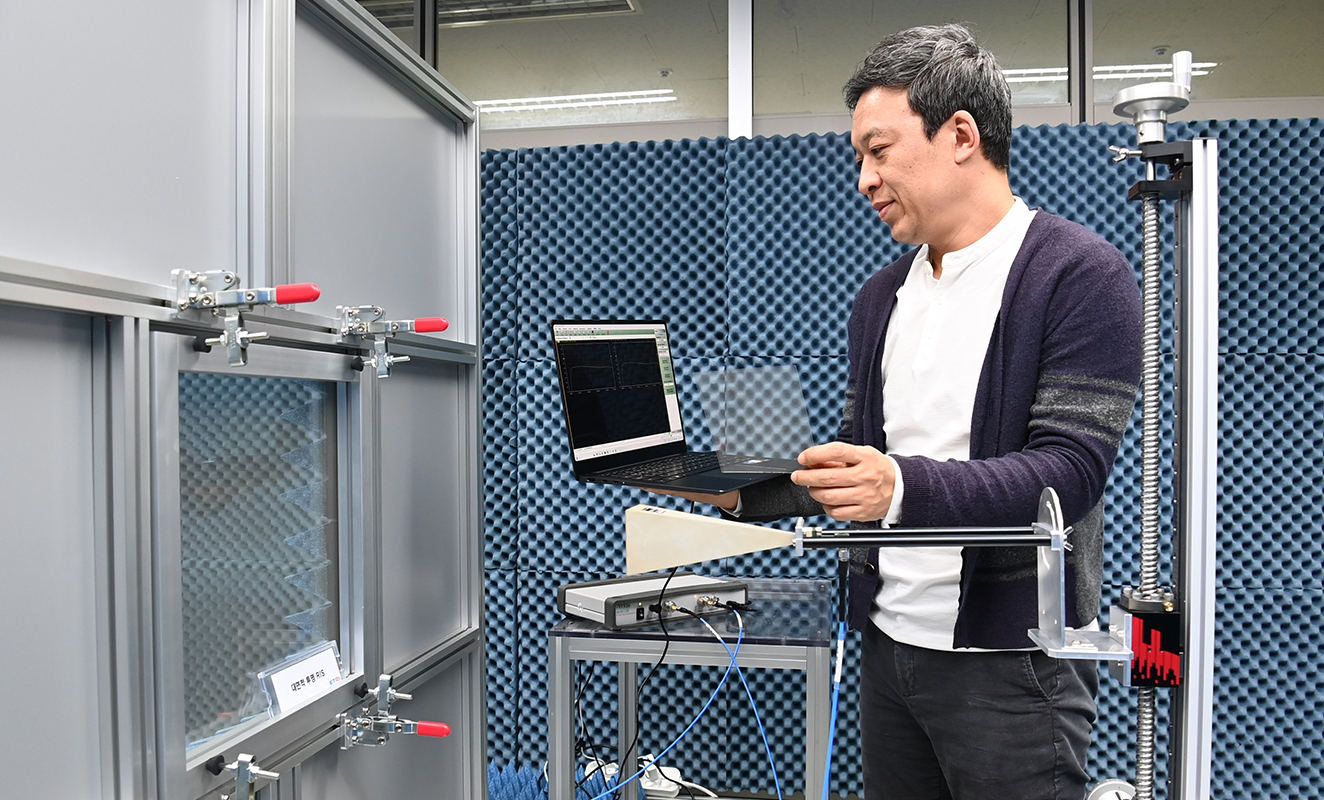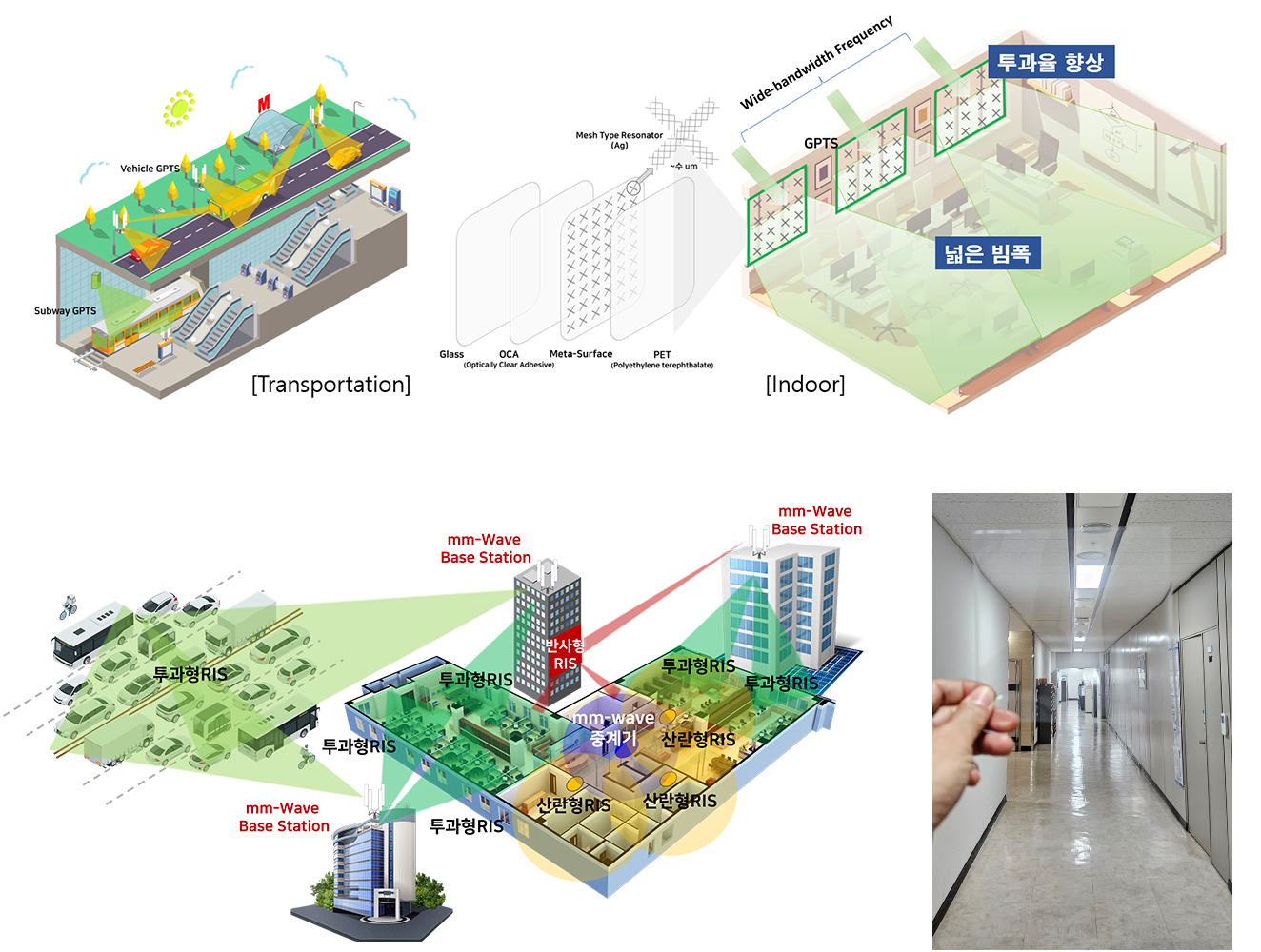ETRI Develops Technology for In-door Communication Without Repeaters
Vol.82 April
- Development of high-penetration, wide-band, wide-angle RIS technology for the millimeter-wave band
- A core technology to expand in-door millimeter-wave communication by attaching it to building glass

Korean researchers have successfully developed a technology that enables in-door millimeter-wave (mm-Wave)1) mobile communication without repeaters. By reducing signal loss and improving communication quality, this technology is expected to become a key solution for the future high-frequency era.
Electronics and Telecommunications Research Institute (ETRI) announced the development of a Reconfigurable Intelligent Surface (RIS)2) technology with high penetration, wide bandwidth, and wide-angle transmission capabilities in the mm-Wave band.
Since 5G and 6G services use high-frequency signals that propagate in high directivity, most signals transmitted from out-door base stations are blocked by building exteriors. Even signals transmitted through windows are attenuated by the glass.
This has caused a deterioration in in-door communication quality due to signal loss through windows. Despite the high 5G in-door facility connection rate, LTE priority mode was applied, so it had to be used as LTE communication. To solve this problem, telecommunication companies had to install additional expensive repeaters in-doors which had the disadvantage of increasing costs.
1) Millimeter-wave (mm-Wave): Electromagnetic waves with a frequency wavelength in the range of 0.1 to 10 mm
2) Reconfigurable Intelligent Surface (RIS): A technology for adjusting incoming radio waves to reflect or transmit radio waves based on their characteristics.
 Overview of Reconfigurable Intelligent Surface (RIS)
Overview of Reconfigurable Intelligent Surface (RIS)
To address this issue, ETRI is actively researching RIS technology that receives radio waves by attaching transparent film or panel-type compact array antennas to building windows or walls. (see photo)
The researchers formed micro-patterns just micrometers (μm) on transparent polyester (PET) film. In the future, if this technology is commercialized and the film is attached to the windows of the interior and exterior walls of a building, it will act as a repeater that enables communication.
When normal radio waves are irradiated onto the antenna by the micro-patterns formed on the surface, it exhibits the property of enhanced transmission. Accordingly, the reach and transmittance of radio waves differ depending on the shape of the micro-pattern.
Once commercialized, this antenna technology is expected to improve signal strength and data speeds in in-door radio shadow areas simply by sticking it onto windows.
RIS technology is a useful component technology that is applied to expand the scope of mobile communication services, especially in high frequency bands with high transmission and transmission losses, but there are many limitations to its use due to its narrow-band frequency characteristics.
However, the high-penetration, broadband, wide-angle RIS developed by ETRI has a bandwidth3) nearly 10 times wider than that of conventional RIS. A single RIS can be utilized simultaneously for 5G, private 5G4), and future 6G services. It also maintains high penetration at wide incident angles of over 80 degrees, making it highly effective for enhancing in-door coverage.
ETRI researchers are also working on developing a scattering-type RIS technology for expanding indoor communication environments. Scattering-type RIS is a new concept of radio wave technology that expands the communication area by re-radiating high-frequency signals transmitted indoors over a wide range of tens of degrees or more. RIS does not require any power to operate, making it one of the future radio technologies for carbon reduction.
The main goals of the researchers working on this technology are to develop glass penetration transparent surfaces and beam-reconfigurable scattering antennas to minimize in-door radio shadow areas. In addition, it aims to develop mobile communication system technologies to expand service coverage based on re-configurable intelligent surfaces.
The researchers explained that at higher frequencies above the millimeter-wave band, communication signals are lost by metal or building walls and transmitted through windows. Signals transmitted through windows suffer from signal loss due to glass, resulting in reduced communication quality and radio shadow areas.
Therefore, if a transparent RIS that can overcome loss is developed and attached to a window, communication quality can be improved and communication areas can be expanded without installing additional repeaters.
In addition, the researchers plan to further improve the annual transmittance characteristics and extend the indoor receive beam width to obtain world-class technology. The current level of transmission loss improvement is about four times that of ordinary glass, and they plan to increase it to six times in the future. This could improve transmission losses not only in ordinary glass, but also in coated and low-E glasses with very high propagation attenuation, and the researchers expect that the range of applications would be limitless. The technology will be transferred to antenna component companies and commercialized within three years.
“ETRI will contribute to the expansion of radio wave technology in Korea to provide various services, including telecommunications, by overcoming the medium limitations of radio waves,” said Dr. Lee Jung Nam of ETRI’s Radio Environment & Monitoring Research Section, who is leading this technology development.
The achievement is part of the “Development of Service Coverage Extension Technologies for 5G-Advanced Mobile Communications Based on Reconfigurable Intelligent Surface” project of the Ministry of Science and ICT and the Institute of Information & Communications Planning & Evaluation (IITP). CLEVERLOGIC Co., Ltd. and DS Navcourse Co., Ltd. are participating in the research.
3) Bandwidth: The width of the frequency used to carry the signal (the difference between the highest and lowest frequency).
4) Private 5G: A service that utilizes 5G technology to build networks tailored to specific areas, such as smart factories, schools, and subways.
Lee Jung Nam, Principal Researcher
Radio Environment & Monitoring Research Section
(+82-42-860-1884, jnlee77@etri.re.kr)